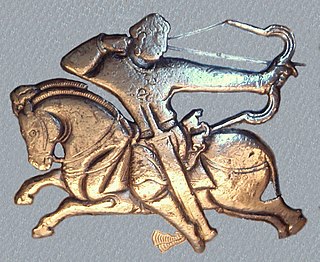
Lucius Aemilius Paullus was a Roman consul twice, in 219 and 216 BC.

The Parthian shot is a light horse military tactic made famous by the Parthians, an ancient Iranian people. While being in real or feigned retreat, their horse archers would turn their bodies back in full gallop to shoot at the pursuing enemy. The maneuver required superb equestrian skills, since the rider's hands were occupied by his composite bow. As the stirrup had not been invented at the time of the Parthians, the rider relied solely on pressure from his legs to guide his horse.

Silius Italicus, in full Tiberius Catius Asconius Silius Italicus, was a Roman consul, orator and epic poet of the Silver Age of Latin literature. His only surviving work is the 17-book Punica, an epic poem about the Second Punic War and the longest surviving poem in Latin at over 12,000 lines.

The Italicus Express massacre was a terrorist bombing in Italy on a train of the public rail network. During the early hours of August 4, 1974, the bomb attack killed 12 people and wounded 48. Responsibility was claimed by the neo-fascist terrorist organization Ordine Nero.

Askeptosaurus is an extinct genus of prehistoric marine reptiles in the order Thalattosauria. Their fossils have been found in the areas what are now Italy and Switzerland. It is believed to have lived in the Middle Triassic period, around 247 to 225 million years ago.
The Ilias Latina is a short Latin hexameter version of the Iliad of Homer that gained popularity in Antiquity and remained popular through the Middle Ages. It was very widely studied and read in Medieval schools as part of the standard Latin educational curriculum. According to Ernest Robert Curtius, it is a "crude condensation", into 1070 lines. It is attributed to Publius Baebius Italicus, said to be a Roman Senator, and to the decade 60 CE – 70 CE. It includes at least two acrostic elements: the first lines spell out ITALICUS, while the last lines spell SCRIPSIT, taken together translating "Italicus wrote (it)."

The Italian newt is a species of salamander in the family Salamandridae found only in Italy. Its natural habitats are temperate forests, temperate shrubland, Mediterranean-type shrubby vegetation, freshwater lakes, intermittent freshwater lakes, freshwater marshes, intermittent freshwater marshes, arable land, pastureland, rural gardens, water storage areas, ponds, and canals and ditches. It is threatened by habitat loss. It was formerly known as Triturus italicus, but was relocated to the genus Lissotriton after Triturus was split.
Dipljapyx is a genus of diplurans in the family Japygidae.

Virgil's Tomb is the title of at least three paintings completed by Joseph Wright of Derby between 1779 and 1785.

Calliptamus italicus, the Italian locust, is a species of 'short-horned grasshopper' belonging to the family Acrididae, subfamily Calliptaminae.

The Sedetani were an ancient Iberian (Pre-Roman) people of the Iberian peninsula. They are believed to have spoken a form of the Iberian language.

Actinoplanes italicus is distinguished by the cherry-red color of its vegetative mycelium, and by the production of soluble pigments. It is also known to produce sporangia when cultured on starch or skim milk agar. Very few strains have been found and cultured, thus A. italicus is relatively uncharacterized.
Dipljapyx beroni is a species of forcepstail in the family Japygidae.
Dipljapyx fagniezi is a species of forcepstail in the family Japygidae.
Dipljapyx hirpinus is a species of forcepstail in the family Japygidae.
Dipljapyx limbarae is a species of forcepstail in the family Japygidae.
Dipljapyx nexus is a species of forcepstail in the family Japygidae.
Dipljapyx sardous is a species of forcepstail in the family Japygidae.
Dipljapyx silanus is a species of forcepstail in the family Japygidae.
Italicus was a chieftain of the Germanic Cherusci.








